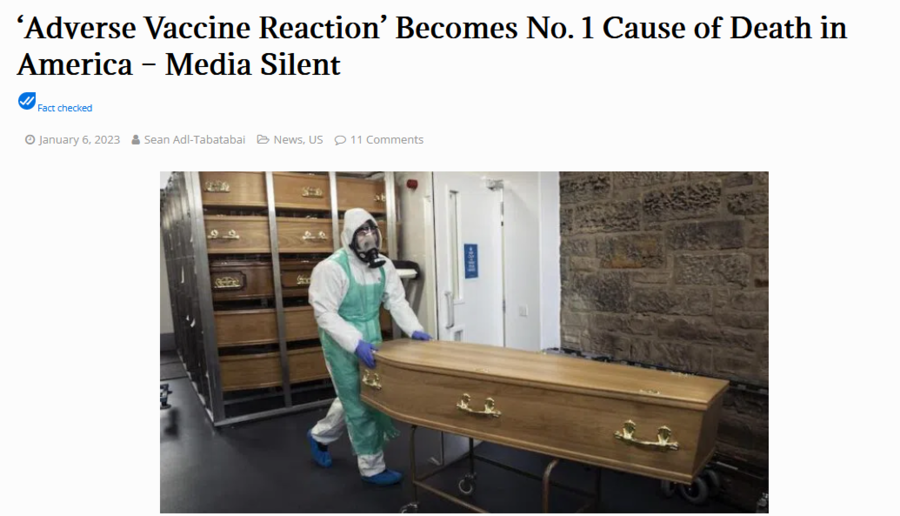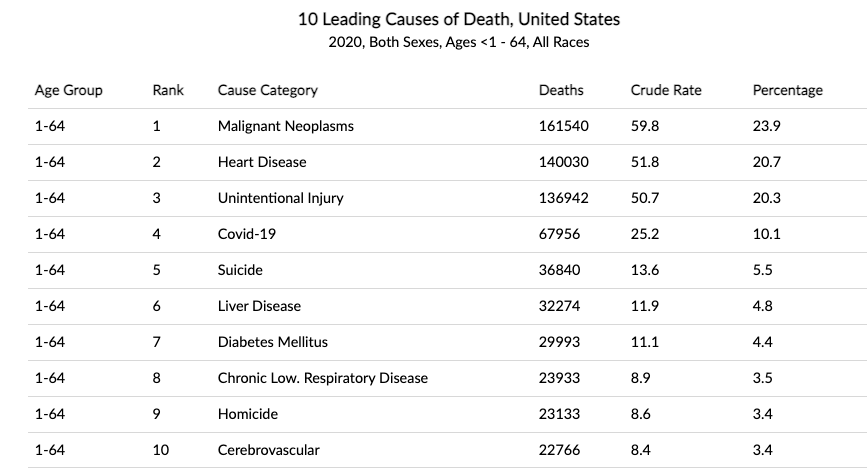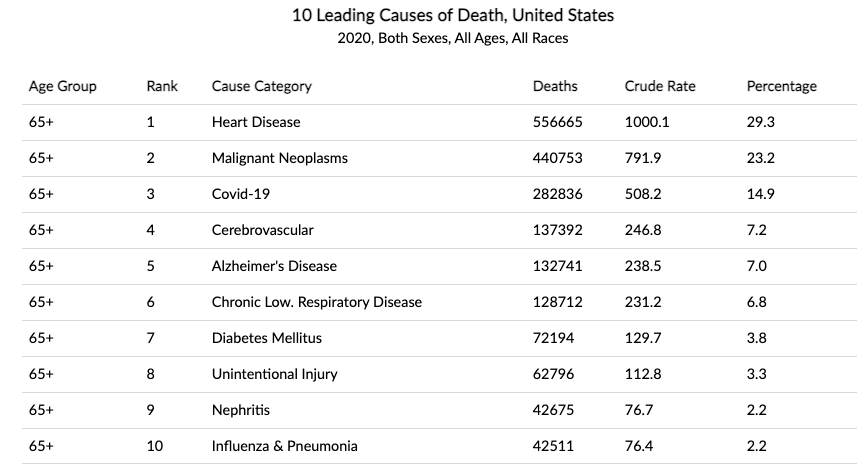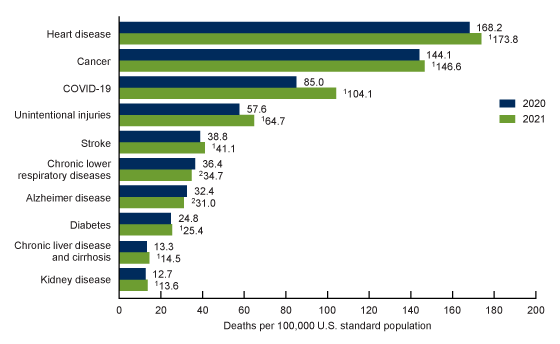Fact Check: ‘Adverse Vaccine Reactions’ Did NOT Become Leading Cause Of US Deaths In 2021 Or 2022
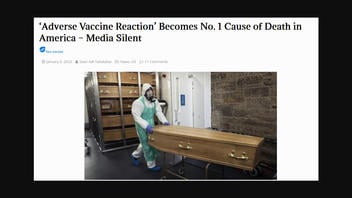
Did “adverse vaccine reaction” become the leading cause of U.S. deaths in 2021 and 2022? No, that’s not true: Adverse vaccine reactions are not a categorical cause of death tracked by health officials. Also, the vaccination status and records of deceased individuals are not tracked.
In both 2021 and 2022, experts told Lead Stories that the leading cause of death in those under 65 was cancerous tumors. Over the same time period, the leading cause of death for those 65 and older was diseases of the heart. The data cited in this claim, which came entirely from online surveys, did not follow basic scientific principles.
The claim originated in a News Punch article published on January 6, 2023, titled, “‘Adverse Vaccine Reaction’ Becomes No. 1 Cause of Death in America – Media Silent” (archived here). The introduction of the article read:
A new study has confirmed that adverse vaccine reactions have become the number one cause of death in America.
Scientists say they have uncovered evidence showing that COVID jabs destroys people’s immune systems, cause heart problems, and trigger turbo-charged cancers.
Below is a screenshot of the article as of the time of writing:
(Source: News Punch screengrab taken Sun Jan 8 13:01:00 2022 UTC)
The News Punch article relayed misleading information initially published in a Discern Report story, which claimed: “A survey by Steve Kirsch found sudden death is the No. 1 cause of death among those under the age of 65 who got the COVID jab.” Other than in the headline, neither the News Punch nor the Discern Report articles explicitly stated or provided evidence that “vaccine adverse reactions” were the leading cause of death in the U.S. It appeared to be a clickbait headline.
Rather, both articles cited a newsletter posted on the self-publishing platform Substack by Steve Kirsch, a Silicon Valley entrepreneur described by MIT Technology Review as a “misinformation superspreader.” (Lead Stories has fact-checked a number of false claims made by Kirsch regarding COVID and vaccines.) Posted on December 27, 2022, the newsletter was titled, “Now everyone can easily prove the vax should be stopped” (archived here).
Scientifically flawed measure of data
In his newsletter, Kirsch referred to data collected during a “survey” — which he solicited responses for on his Substack on December 25, 2022 (archived here). This data was said to have built upon an earlier survey with results published on December 16, 2022 (archived here). There is no reason to believe that the outcomes of these surveys are credible or lend any credence to claims made in Kirsch’s Substack article, in large part because the results of these surveys are inherently flawed.
Responses were not reported in a legitimate scientific journal, nor were they reviewed by scientific peers to determine the quality of the data and the veracity of the conclusions drawn. To be considered scientifically sound, researchers must be transparent with the data that they collect and study. Kirsch provided no further information about the responses he said he received, including how he controlled for external variables like lifestyle or previous health conditions, whether he vetted the claims made by respondents, the demographic data of the respondents (including age, ethnicity, race, sex and geographic location) or whether he verified that the death and cause of death reported were authentic. Additionally, the value of surveys using self-reported information from participants, especially a survey of readers of an anti-COVID-vaccine blog like Kirsch’s, is limited as a method of gathering public health statistics about Americans overall.
“Sudden death”
The Centers for Disease Control and Prevention (CDC) tracks mortality statistics and publishes this data. Lead Stories analyzed CDC mortality data and contacted the CDC National Center for Health Statistics (NCHS). In an email sent to Lead Stories on January 10, 2023, NCHS defined “sudden death” as the following:
‘Sudden death’ simply describes the timing of death. It is not a cause of death. Many causes of death may be sudden, e.g., most deaths involving unintentional injury, homicides and suicides are sudden. A death caused by a heart attack or stroke may also be sudden. That said, not all are. In any case, NCHS data do not distinguish whether the death occurred suddenly or not.
And because vaccine status is not tracked by the NCHS, there is no such thing as an “adverse vaccine reaction” cause of death.
2020 mortality statistics
In 2020, the leading cause of death for both sexes, all ethnicities, each region and every race in the U.S. for those under 1 year old was congenital anomalies, or birth defects (4,043, 30.6 percent). In those between 1 and 64, the leading cause of death was malignant neoplasms or a cancerous tumor (161,540, 23.9 percent), followed by heart disease (140,030, 20.7 percent) and unintentional injury, which includes opioid overdoses and motor vehicle crashes (136,942, 20.3 percent). COVID was considered the fourth leading cause of death (67,956, 10.1 percent).
Here is a table representation of the above data, which includes the percentage of deaths attributed to each cause:
(Source: CDC)
In those over 65, the CDC reported that in 2020, the leading cause of death was heart disease (556,665, 29.3 percent), followed by malignant neoplasms (440,753, 23.2 percent) and COVID (282,836, 14.9 percent).
Here is a table representation of the above data, which includes the percentage of deaths attributed to each cause:
(Source: CDC)
2021 mortality statistics
The CDC stated in its 2021 mortality summary that:
In 2021, 9 of the 10 leading causes of death remained the same as in 2020. The top leading cause in 2021 was heart disease, followed by cancer and COVID-19.
Chronic liver disease and cirrhosis became the 9th leading cause of death in 2021, while influenza and pneumonia dropped from the list of 10 leading causes.
The age-adjusted 10 leading causes of death in 2021 can be seen in the chart below (green) compared with figures from 2020 (blue).
(Source: CDC)
NCHS confirmed to Lead Stories that the leading cause of death in 2021 for those under 65 was cancerous tumors. Over the same time period, the leading cause of death for those 65 and older were attributed to diseases of the heart. The following data was provided to Lead Stories by NCHS and includes provisional 2021 numbers as of January 10, 2023.
10 leading causes of death in 2021, ages less than 65
- Malignant neoplasms (158,852; 16.4%)
- Accidents (155,913; 16.1%)
- Diseases of the heart (142,309; 14.7%)
- COVID-19 (134,433; 13.9%)
- Intentional self-harm (suicide) (38,527; 4%)
- Chronic liver disease and cirrhosis (35,896; 3.7%)
- Diabetes mellitus (30,843; 3.2%)
- Assault (homicide) (24,727; 2.6%)
- Cerebrovascular diseases (23,632; 2.4%)
- Chronic lower respiratory diseases (22,188; 2.3%)
10 leading causes of death in 2021, ages 65 and older
- Diseases of the heart (553,214; 22.2%)
- Malignant neoplasms (446,354; 17.9%)
- COVID-19 (282,457; 11.3%)
- Cerebrovascular diseases (139,257; 5.6%)
- Chronic lower respiratory diseases (120,152; 4.8%)
- Alzheimer disease (117,922; 4.7%)
- Diabetes mellitus (72,451; 2.9%)
- Accidents (unintentional injuries) (69,003; 2.8%)
- Nephritis, nephrotic syndrome and nephrosis (44,013; 1.8%)
- Parkinson disease (37,568; 1.5%)
2022 mortality statistics
As of January 10, 2023, NCHS told Lead Stories that the agency had “reasonably complete data for the first half of 2022.” Below are the leading causes of death for January to June 2022 based on provisional data.
10 leading causes of death January-June 2022, ages less than 65
- Malignant neoplasms (77,148; 17.7%)
- Accidents (unintentional injuries) (73,152; 16.8%)
- Diseases of heart (68,008; 15.6%)
- COVID-19 (33,706; 7.7%)
- Intentional self-harm (suicide) (19,325; 4.4%)
- Chronic liver disease and cirrhosis (16,586; 3.8%)
- Diabetes mellitus (14,970; 3.4%)
- Cerebrovascular diseases (11,598; 2.7%)
- Assault (homicide) (11,337; 2.6%)
- Chronic lower respiratory diseases (10,895; 2.5%)
10 leading causes of death January-June 2022, ages 65 and older
- Diseases of the heart (284,436; 23%)
- Malignant neoplasms (221,520; 17.9%)
- COVID-19 (105,394; 8.5%)
- Cerebrovascular diseases (71,415; 5.8%)
- Chronic lower respiratory disease (62,390; 5%)
- Alzheimer disease (59,263; 4.8%)
- Diabetes Mellitus (36,250; 2.9%)
- Accidents (unintentional injuries) (34,770; 2.8%)
- Nephritis, nephrotic syndrome and nephrosis (24,070; 1.9%)
- Parkinson disease (19,304; 1.6%)
News Punch has published numerous fake news articles in the past. Their Facebook page “The People’s Voice” lost its verification checkmark according to a 2018 report from Media Matters For America.
The Terms of Use of the site (archived here) also make it clear News Punch does not stand behind the accuracy of any of their reporting:
NEWSPUNCH, LLC AND/OR ITS SUPPLIERS MAKE NO REPRESENTATIONS ABOUT THE SUITABILITY, RELIABILITY, AVAILABILITY, TIMELINESS, AND ACCURACY OF THE INFORMATION, SOFTWARE, PRODUCTS, SERVICES AND RELATED GRAPHICS CONTAINED ON THE SITE FOR ANY PURPOSE.
Lead Stories has fact-checked a number of claims made by Steve Kirsch that can be viewed here.
This article has been archived for your research. The original version from Lead Stories can be found here.
